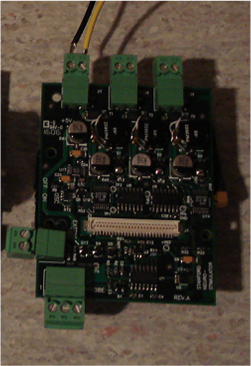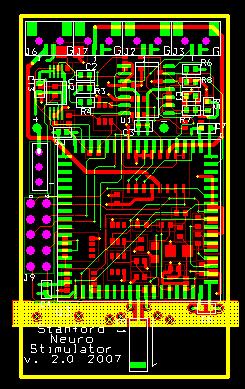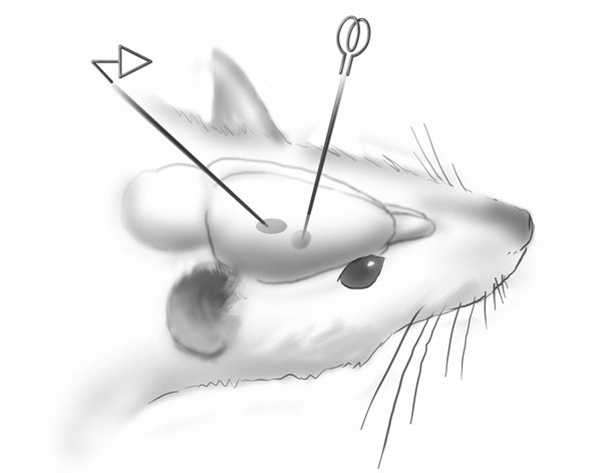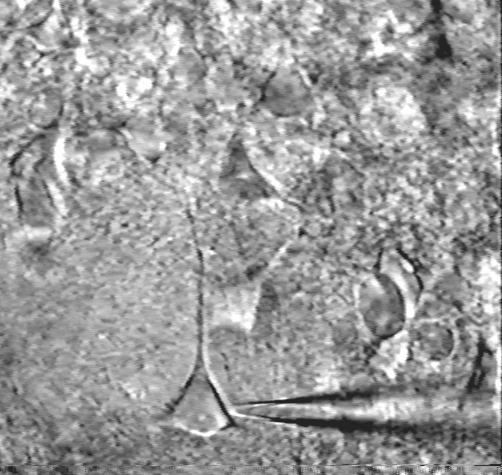|
People:
Stanford: Phil Levis, Zhe Chen, Megan Wachs, Lei Yang, Arjun Agarwal, Nishant Patil
UC San Francisco: Rob Froemke
Introduction:
We are working with neuroscientists at UCSF to create a device that will allow the study
brain activity in rats, specifically in social situations. What happens in a rat's brain when it sees its mother? Can applying brain stimulation when one rat meets another change the way they behave towards eachother? While there are current devices that allow brain stimulation or recording, these devices are often wired, making it difficult to study the animals when they are moving and interacting. To enable these sorts of measurements, we are designing a device that is:
- wireless
- lightweight
- completely programmable
- capable of both recording and stimulating brain activity.
Board Design:
Recording

A typical intercelluar spike is 100 mV in amplitude and lasts for about 1ms.
|
There are two distinct signals in the brain that the neuroscientists are interested in recording. The first is EEG, measured with a coarse probe on the outside of the head, which is a low-frequency(.1-1 Hz), low-amplitude (10-1000 microvolt) signal. The second is high-frequency spikes of activity at individual neurons, measured with extremely thin embedded electrodes. These spikes can be up to 100 millivolts in size, lasting about a millisecond.
|
Stimulation
Stimulation consists of controlled pulses of current to certain areas of the brain. These pulses are sent through thin electrodes, which have a high resistance because they are so fine. Since our device operates on a 3V power supply, special circuitry is required to boost the voltage up to 20V to supply enough current for deep-brain stimulation.
Prototypes

Original prototype board, shown without attached Micaz mote or batteries.
|
In 2006 we designed a prototype board which attaches to a Micaz mote via a 51-pin connector. This device was powered by the 2 AA batteries in the mote. The board had a single input channel which amplified the input signals by 10,000x and bandpassed the signals to .1 - 30 kHz. The board-and-mote combination proved to be too large for a rat to wear comfortably, leading to the design of a second prototype.
|
The second prototype allows utilizes the Micaz OEM module to reduce the size of the overal system. The OEM module is attached directly to a single PCB which measures less than 1.5" x 2.5", which is roughly the size of a regular Mica or Telos mote. This prototype features:
- An input channel dedicated to measuring EEG signals: this channel is low-pass filtered and amplified before being sent directly to the Atmega 1281's internal ADC.
- A second input channel dedicated to measuring intercellular spikes: this channel has a higher cut-off frequency and less amplification than the EEG signal. Because it needs to be sampled at a higher rate, it is sent to an external ADC chip which interfaces with the Mica OEM via SPI.
- 2 output channels: a 20V output for deep-brain stimulation, and a 5V output for local stimulation. The current pulses' duration, frequency, and intensity are all configurable through software.
Rather than powering this device with AA batteries, which proved to be too heavy for a rat to wear comfortably, we use a single 3V watch battery. A low-profile chip antenna is used to extend the range of the Micaz's radio.
|

PCB Layout of the second prototype board
|
Publications:
Robert Froemke, Megan Wachs, Zhe Chen, Prabal Dutta, Gary Myers, Glen
Glassner, C.E. Schreiner, M.M. Merzenich, and Philip Levis.
"A Wireless Device for Combined Subcortical Stimulation and Cortical
Recording."
The 4th Annual National Academies Keck Futures Initiatives on Smart
Prosthetics: Exploring Assistive Devices for the Body and the Mind,
2006.
|




